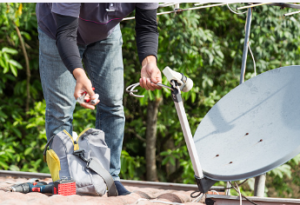If you’re ready to install a TV antenna, you should know a few things:
- You’ll need to know what type of antenna you need.
- Make sure it’s compatible with your TV.
- You should know the size of your antenna.
- Consider the signal strength and direction.
 Coaxial cable compression fittings
Coaxial cable compression fittings
Before installing a TV antenna, ensure you have all the necessary pieces. For instance, you may have to replace some of your old wirings, or you may have to add new ones. If you don’t have any of the pieces, you should consider getting a distribution amplifier to help boost the signal. These devices can boost the signal enough to overcome splitters and can be purchased in various sizes. In addition, you will want to use compression fittings to avoid the hassle of having to crimp connectors or screw on connectors.
The type of coax cable that you’ll need also affects which type of connector you use. RG-6 Quad, for example, requires a different connector than RG-59. Also, avoid running electrical cables parallel to the coaxial cable as it may interfere with the signal.
Size of antenna
Size is an important consideration when installing an antenna installation Adelaide. The antenna should be at least 20 feet (6 meters) from any power lines. If the antenna is installed too close to a power line, the local power company will have to remove it and replace it with a new one. In addition, it is important to install the antenna in the correct location. The coaxial cable should also be of the right length for the installation. It will help improve reception.
You’ll also need a digital converter for every TV connected to the antenna. A rotator is also recommended, though optional if you choose a unidirectional antenna, and you’ll also need a hammer drill and a regular drill if you install the antenna on a brick or cement block wall.
Direction of signal
When installing an antenna, you should always consider the direction of the television signal it will receive. The antenna’s front shaft, containing the receivers, should point to the source of the signal. Moreover, it should be oriented the right way up. The antenna receives a signal from broadcast towers located throughout the country. The number of channels you receive will depend on the distance from the tower and the quality of the signal.
You can use a pre-amplifier at the antenna to boost weak signals. Besides you can also use passive splitter devices to distribute the signal to several televisions.
Signal strength
The signal strength of your TV antenna installation Adelaide is an important consideration. There are several ways to increase signal strength:
- You must ensure the antenna is facing the correct direction. In addition, it must be aligned with neighbouring TV antennas and the direction of your home’s map.
- It should have the appropriate polarization. Typically, antennas are installed horizontally, although they can also be installed vertically.
- It would help if you connected a signal strength meter to the lead of your antenna.
- It would help if you connected it to the television’s signal output.
Antenna selection is a difficult task. Some online guides and resources explain which antennas will work in your area. However, they cannot be a 100% guarantee, as signal strength varies according to geographic conditions. For example, a signal may bounce off hills or other obstacles or be reduced when trees sprout leaves.
Signal strength meter’s range
To check a TV antenna’s signal strength, you need a meter to measure it accurately. TV signal strength meters are useful when installing or repositioning an antenna. They also help you determine if your antenna is transmitting the right signal to your TV. A TV signal meter’s range depends on the antenna’s placement.
A TV antenna signal meter has a built-in compass that can help you point the antenna in the right direction. However, be sure to check the sensitivity and setup of the device before installing it.
The installation of a TV antenna is not only the most inexpensive way to watch HDTV, but it is also more environmentally friendly than satellite services. Because it works through mechanical principles, it doesn’t use extra energy, unlike satellite services. Moreover, you don’t have to sign up for any contracts or agreements with companies offering these services. However, it is important to remember that multidirectional TV antennas are not cheap. It is because they require a coaxial cable that is fifty feet or longer.
